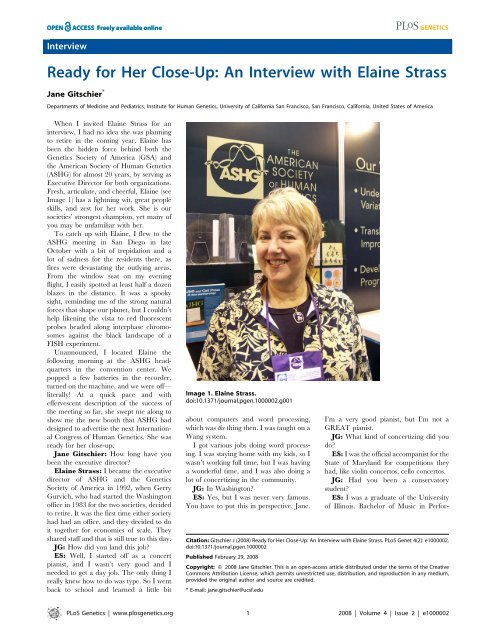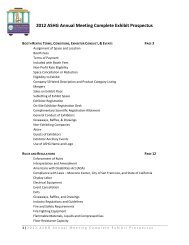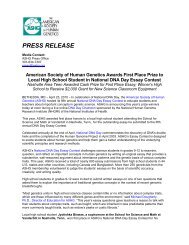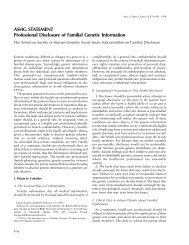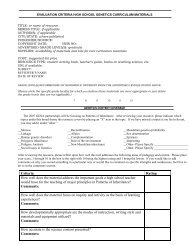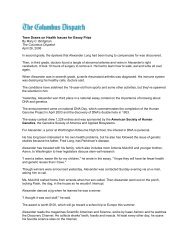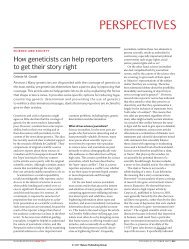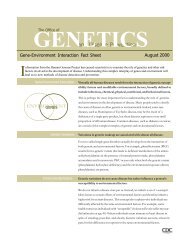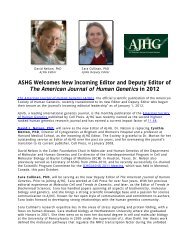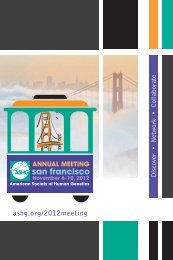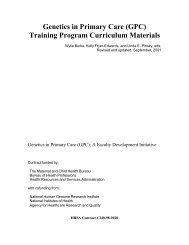An Interview with Elaine Strass - The American Society of Human ...
An Interview with Elaine Strass - The American Society of Human ...
An Interview with Elaine Strass - The American Society of Human ...
Create successful ePaper yourself
Turn your PDF publications into a flip-book with our unique Google optimized e-Paper software.
street, I didn’t see many Nobel Prizewinners!But I do now!<strong>An</strong>d one <strong>of</strong> the biggest thrills at GSA thisyear has been the realization that GSA hasbeen making awards, and the recipientsthen go on to win the Nobel Prize. <strong>The</strong>GSA Medal went to Bob Horvitz and thenhe won the Nobel, and then to <strong>An</strong>dy Fire,and he won the Nobel. John Sulston wasanother awardee, and then he won theNobel. This year we awarded OliverSmithies, and he just won the Nobel! Webeat the Nobel to it! It made us feel terrific.<strong>The</strong> GSA has three awards traditionally.<strong>The</strong>re was the Thomas Hunt MorganAward, which is a medal and it’s beengiven since the early 60s, and there is apicture <strong>of</strong> a fly on the medal and on theother side is Thomas Hunt Morgan’sportrait—4.5 inches in diameter, madeout <strong>of</strong> pewter. <strong>An</strong>d this is the big one.You get this award when you have shownlifetime contributions to the field <strong>of</strong> geneticresearch.<strong>The</strong> GSA Medal was developed a fewyears later. Why should we have to waitfor a whole lifetime for contributions tooccur before we can honor someone? <strong>The</strong>idea for the GSA Medal was a breakthrough<strong>with</strong>in the last 15 years. <strong>An</strong>d thatwas the one that Horvitz won, forapoptosis, programmed cell death. Hehad other things, too. It was not difficultto give Bob that award!<strong>An</strong>d Oliver Smithies, <strong>of</strong> course, for hisgreat contributions—he got the ThomasHunt Morgan Medal for lifetime contributions.JG: So the GSA Medal is like the CurtStern Award that ASHG gives.ES: Yes, it’s the parallel to that.GSA wanted to honor people, startingabout six years ago, for service to thecommunity. It’s called the George W.Beadle award. We have people who havemade enormous contributions, who havemade the lives <strong>of</strong> the scientists so mucheasier and even possible. Like, if you ran astock center for 20 years, you might notget a scientific award, but, my goodness,your donation to the community is soenormous! So that’s why the BeadleAward was developed and every year wecome up <strong>with</strong> some really great winners.JG: With GSA having all these separatemeetings, how do they coalesce to makedecisions about things?ES: It’s a good question. Let’s take astep back and look at the bigger picture.We have different models for societies.We have <strong>Society</strong> for Neuroscience <strong>with</strong>48,000 members. When they have ameeting and 34,000 people come, the cityknows that they are there because theyhave taken every single hotel room. <strong>The</strong>yhave so many poster presentations thatthey have a complete poster session in themorning, then they take it down andanother complete one goes up in theafternoon, and that goes on for five days.<strong>The</strong> scale is different from both ASHGand GSA.<strong>The</strong>re is a drawback there becausewhen you go to meeting <strong>of</strong> that size, it’shard to run into people. <strong>The</strong>y havespecialties, too, but they elected to keepeverything together. I remember when Iworked there, there was always the threatthat the behavior neuroscientists wouldsplit <strong>of</strong>f! ‘‘We don’t like the way the boardis treating us and we’re going to split <strong>of</strong>f!’’But they never split <strong>of</strong>f.Still you know where you fit in, yourlittle corner in the very large meeting.ASHG is kind <strong>of</strong> in the middle. We gettogether once a year, we know we canbump into people we want to bump into.We have little cubbyholes to leave messages.However, we also have <strong>American</strong> <strong>Society</strong>for Gene <strong>The</strong>rapy, NSGC (National<strong>Society</strong> <strong>of</strong> Genetic Counselors), HUGO(<strong>Human</strong> Genome Organization), the<strong>American</strong> College <strong>of</strong> Medical Genetics—all these other groups who are very close toASHG. But the ASHG meeting is theresearch meeting, and we have chosen notto do the neuroscience route, which is toinclude everyone at one meeting.<strong>The</strong> way I interpret it—genetics isnature’s way <strong>of</strong> making diversity, and that’swhat we’ve got in the genetics community.All these organism guys, they reallydon’t want to meet <strong>with</strong> each other. <strong>The</strong>yeast guys don’t want to meet <strong>with</strong> theworm guys and and they don’t want to be<strong>with</strong> the fungal guys. <strong>The</strong>y call Clamydamonasguys the ‘‘pond scum’’ guys. <strong>The</strong>Drosophilists have their own wonderfulcommunity. <strong>The</strong>y have their own board <strong>of</strong>directors, even though they are notincorporated. It’s very loose, they don’thave to file reports.So the question is—could there be areally large model organism meeting? Itwould be about 9,000 people, and I’vegiven this a lot <strong>of</strong> thought. Possibly serialoverlapping meetings. But nobody is hotto do that. <strong>The</strong>y like their small meetings,which are very predictable, good ways forstudents to present their first poster or talk,and to teach students how it is done—howto meet the right people and publish.JG: So, <strong>with</strong> all these independentmeetings, how does GSA come together?ES: <strong>The</strong>re is the journal Genetics. GSAwas started in 1931 and the journal in1916! <strong>An</strong>d all <strong>of</strong> those old issues are on theJournal Web site through Highwire Press.So the Journal acts like a coalescing factor.<strong>An</strong>d the GSA board has been discussingthis for years, and that why they came up<strong>with</strong> the Model Organism to <strong>Human</strong>Biology (MOHB) meeting, which meetsin San Diego every other January.This was actually a decision made whileMark Johnston, a yeast researcher, waspresident <strong>of</strong> the GSA, and he happens tobe a very visionary person. He, along <strong>with</strong>many others on the board, the Drosophilists,thought it was time to bring thingstogether. Part <strong>of</strong> it had to do <strong>with</strong> the factthat everything is getting sequenced, andthis made a huge difference in the way welook at genetics research and the future asgeneticists and genomicists. <strong>The</strong>re’s a lotmore that we have in common because <strong>of</strong>these important features. <strong>An</strong>d the Journalsacknowledge this, but having a meetingwhere you have the human and theDrospholist and all talking about the samegene—in yeast and worm.At the last MOHB meeting, I wasfloored.JG: So you went to the sessions?ES: I always go to the sessions. I don’tknow how I can understand them, becauseI’m not trained as a geneticist. To me,genetics is the mechanics <strong>of</strong> the tinkertoys<strong>of</strong> life. It’s a huge puzzle and I love the ideathat it could be decoded, that it could besequenced. <strong>The</strong> idea that somebody wouldinvent PCR. I understand enough to seethe wonder <strong>of</strong> all this.JG: You’re tearing up!ES: I’m just an old sentimental fool.To see the changes in the field! I’malmost an outsider. I don’t understandenough to really appreciate everythingthat’s going on, but when somebody getsthe Nobel Prize, I understand.JG: Why are you retiring?ES: Well, I’m more aged than I look!I’ve got old arteries. I have to take care <strong>of</strong>myself. This is a big job. A $9M budget—two budgets! <strong>An</strong>d a lot <strong>of</strong> travel, if you goto all the meetings. I go to everything—Iwouldn’t miss anything—it’s too exciting!<strong>An</strong>d that’s a problem I have; if I could stepback and not be as involved, it would bebetter for me. I can’t seem to do that! So, Iannounced two years ago that I was goingto retire.<strong>The</strong>re are other things I want to do. Goback to music and work in the community.I’m starting a business called ‘‘Dial-a-Daughter.’’ I will take old people whocan’t drive any more who want to dothings <strong>with</strong> me, like go to the opera or outto lunch. I will devote my time to helpingthese people live.PLoS Genetics | www.plosgenetics.org 3 2008 | Volume 4 | Issue 2 | e1000002
This will be my new life, and I <strong>of</strong> coursewill continue to be a member <strong>of</strong> GSA andASHG.<strong>The</strong>re are so many people who havehelped me—these people are wonderful. Iadore geneticists! Warm people who justhelped me understand anything I didn’tunderstand and helped me get through thethings I wanted to get through. This hasbeen a real ‘‘love in,’’ for all these years.For me, it’s the end <strong>of</strong> an era, and whenI look back on my life, this has been thebest part <strong>of</strong> it. <strong>The</strong>re is no question thatwhat I have here is rewarding andexciting—it’s a dream job, and it’s allbecause <strong>of</strong> these two societies.PLoS Genetics | www.plosgenetics.org 4 2008 | Volume 4 | Issue 2 | e1000002


